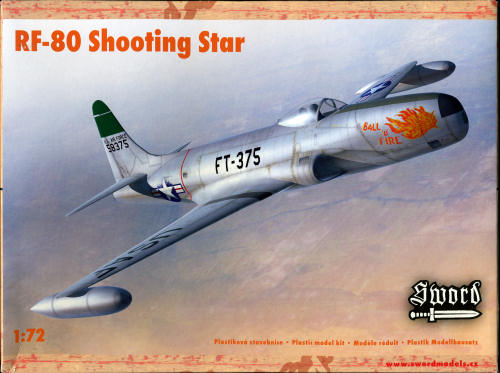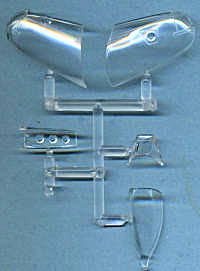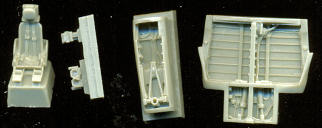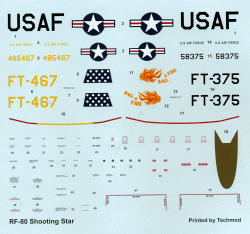
| KIT #: | SW72026 |
| PRICE: | $29.95 SRP |
| DECALS: | Two options |
| REVIEWER: | Scott Van Aken |
| NOTES: | New mold kit with resin parts |

| HISTORY |
The Lockheed P-80 Shooting Star was the first jet fighter used operationally by the United States Army Air Forces, and saw extensive combat in Korea with the United States Air Force as the F-80. As one of the world's first successful turbojet-powered combat aircraft, it helped usher in the "jet age" in the USAF and other air forces worldwide. One of its claims to fame is in training a new generation of pilots, especially in its closely-related, and actually faster, T-33 Shooting Star trainer development.
Shooting Stars first saw combat service in the Korean War, employing both the F-80C variant and RF-80 photo-recon variants. The first jet-versus-jet aircraft battle took place on 8 November 1950 in which Lieutenant Russell J. Brown, flying an F-80, claimed a MiG-15 shot down. Despite the initial claim of success, the straight-wing F-80s were inferior in performance to the MiGs and were soon replaced in the air superiority role by the swept-wing F-86 Sabre. When sufficient Sabres were in operation, the Shooting Star was assigned to ground attack missions, advanced flight training duties and air defense in Japan. By the end of hostilities the only F-80s still flying in Korea were photo-recon variants.
The 8th Tactical Reconnaissance Squadron, later redesignated 15th TRS, served from 27 June 1950 at Itazuke, Japan, Taegu (K-2) and Kimpo (K-14), Korea, until after the armistice. The squadron also utilized a few converted RF-80Cs and RF-86s.
| THE KIT |
 Sword's RF-80A is basically the same kit as their F-80C, but with a
Sword's RF-80A is basically the same kit as their F-80C, but with a  new nose section made from clear plastic. The kit includes two sprues of grey plastic (actually one sprue cut in half to fit into the box) a clear sprue with a separate windscreen and canopy, and a small bag of resin parts. These resin parts consist of the center main gear well, complete nose gear well, seat, gun sight and landing light section. I'm pretty sure the seat is the proper one for a Korean War plane. The resin is superbly done with considerable detail. It would have been nice to have the cockpit tub also in
new nose section made from clear plastic. The kit includes two sprues of grey plastic (actually one sprue cut in half to fit into the box) a clear sprue with a separate windscreen and canopy, and a small bag of resin parts. These resin parts consist of the center main gear well, complete nose gear well, seat, gun sight and landing light section. I'm pretty sure the seat is the proper one for a Korean War plane. The resin is superbly done with considerable detail. It would have been nice to have the cockpit tub also in  resin as the plastic detailing, while good, is not as nice as it would have been in resin. In fact, the plastic tub is somewhat generic without all the little details and panels as on the real aircraft.
resin as the plastic detailing, while good, is not as nice as it would have been in resin. In fact, the plastic tub is somewhat generic without all the little details and panels as on the real aircraft.
Detailing on the plastic parts is excellent with fine engravings. I found flash on several pieces, but this is to be expected from what is really a short run kit. I also noted that the sprue attachment areas intrude into most of the parts so some care will be needed to remove the bits and to clean up these attachment areas. There are blanking plates for the intakes to prevent see-through and the kit comes with both Misawa and standard tip tanks. The majority of planes used the Misawa tanks. Speed brakes are separate items as well with all the appropriate retraction struts included. This is true of the main and nose gear legs. The nose gear has a separate wheel/tire piece.
Two styles of nose wheel are provided, and since the vast majority of RF-80s were the A model, the early wheels would be appropriate for this plane and photos in the reference book show both options with the early nose wheel. However, the kit only has the later ones for the main gear. This may well not be a problem as it was not uncommon for these wheels to be interchangeable. Most will not realize the difference. One thing that is a bit different is that it seems as if the canopy section is for an F-80C. To make it an A canopy, simply sand off the small teardrop section at the b ack until the canopy is pointed in the rear like that of an F-86. The main sprues shot shows the standard F-80 kit since so much is the same. However, the F-80 nose has already been cut off so you simply glue the new one to the fuselage.
ack until the canopy is pointed in the rear like that of an F-86. The main sprues shot shows the standard F-80 kit since so much is the same. However, the F-80 nose has already been cut off so you simply glue the new one to the fuselage.
Instructions are well done with generic color references and indications as to what to paint the small bits during construction. Detail alignment information is given to be sure that we get things properly in position. Though the instructions show that you need to cut the nose away from the standard fuselage, this is not necessary as that operation has already been done for you. Two options are given, with the box art plane from the 1953 time period in unpainted metal. The other is a rare camouflaged RF-80A from 1952. It is in Dark Green over unpainted metal. No indication as to the actual shade of the green, but looking at a photo in the reference shows it is more than likely OD. No wing walk decals are given so paint will be required on the unpainted metal one. The decals themselves are very nicely done by Techmod so no worries on registration or opacity.
| CONCLUSIONS |
So, now we have, for the first time I can recall, a model of the RF-80. I know many who will be pleased with this long overlooked variant.
| REFERENCES |
F-80 Shooting Star Units over Korea, 2001, Warren Thompson. July 2009 Thanks to www.squadron.com for the preview kit. Get yours today at your local shop or on-line retailer If you would like your product reviewed fairly and fairly quickly, please contact the editor or see other details in the Note to Contributors.